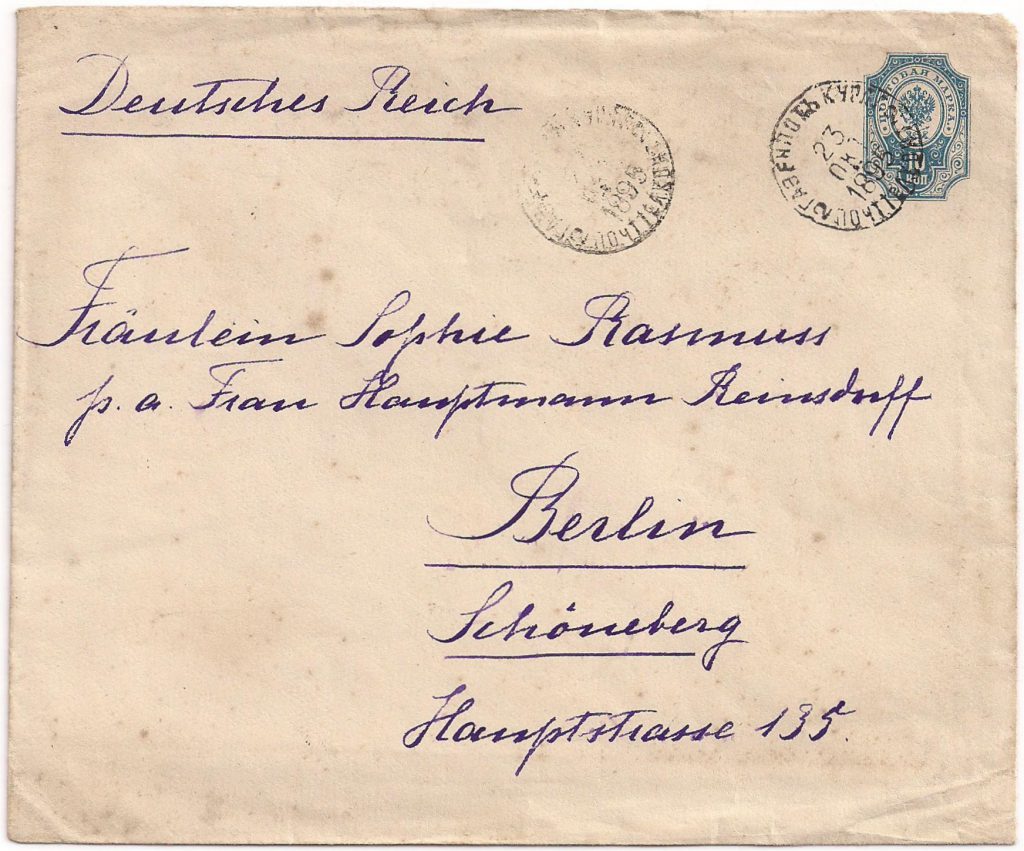
ГАЗЕНПОТЪ [GAZENPOT] is in Imperial Russia the indication for the present Latvian place Aizpute.
This Russian name we see in the postmark.
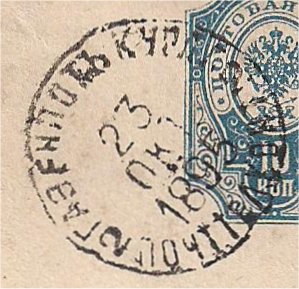
The Russian name in the postmark is more a transcription of the German name Hasenpoth or the Polish name Hazenpot. In the postmark is also indicated the Government: КУРЛ Г. (KURL G.), short for КУРЛЯНДСКАЯ (KURLYANDSKAYA) ГУБЕРНIЯ (GUBERNIYA), Courland Government.
According to the handbook of Hofmann (see sidebar on the right): type 4 with the classification at the bottom ПОЧТ. ТЕЛ. КОНТ. , the abbreviation for ПОЧТОВО-ТЕЛЕГРАФНАЯ КОНТОРА (POCHTOVO-TELEGRAFNAYA KONTORA = Post-Telegraph office), serial number 2, diameter 22 mm, in use 29 05 94 – 15 06 97
The EESTI-handbook of Hurt and Ojaste is the handbook about Estonia, but the classification of circular date-stamps is also useful for Latvia as part of Imperial Russia.
In this classification this postmark of ГАЗЕНПОТЪ [GAZENPOT] is type 6: type post office below and gubernia (when given) at top. (handbook type 6). This postmark has date in three lines, month in letters, with gubernia: type 6A.
The subdivion of type 6A:
- 6A1: indication П.Т.К. or ПОЧТ. ТЕЛ(ЕГР). КОНТ. , the abbrevation for ПОЧТОВО-ТЕЛЕГРАФНАЯ КОНТОРА (POCHTOVO-TELEGRAFNAYA KONTORA = Post-Telegraph Office)
So this postmark of ГАЗЕНПОТЪ [GAZENPOT]: type 6A1. - 6A2: indication П.Т.О. or ПОЧТ. ТЕЛ(ЕГР). ОТД, the abbrevation for ПОЧТОВО-ТЕЛЕГРАФНОЕ ОТДЬЛЕНIЕ (POCHTOVO-TELEGRAFNOE OTDELENIE = Post-Telegraph Sub- Office)
- 6A3: indication П.О. or ПОЧТОВОЕ ОТДЬЛЕНIЕ (POCHTOVOE OTDELENIE = Sub Post-Office
- 6A4: indication П.С or ПОЧТОВОАЯ СТАНЦIЯ (POCHTOVAYA STANTSIYA = Postal Station (coach station)


Here above you see a part of a map with the Government Courland.
Aizpute is located on this map somewthing north-east of Libau (the Latvian Liepāja) and has on the map the German indication Hasenpot.
According Baedeker (1914) from Libau to Hasenpoth is 46 Versts (31 Miles) and it takes by light railway 2½ hrs. The description of Hasenpoth in Baedeker 1914: “a town of 3800 inhab., picturesquely situated on the Tebber. On the left bank is a ruined castle of the Teutonic Knights, while on the right bank lay the bishop’s castle. Parts of the church-walls date from the 15th century.”
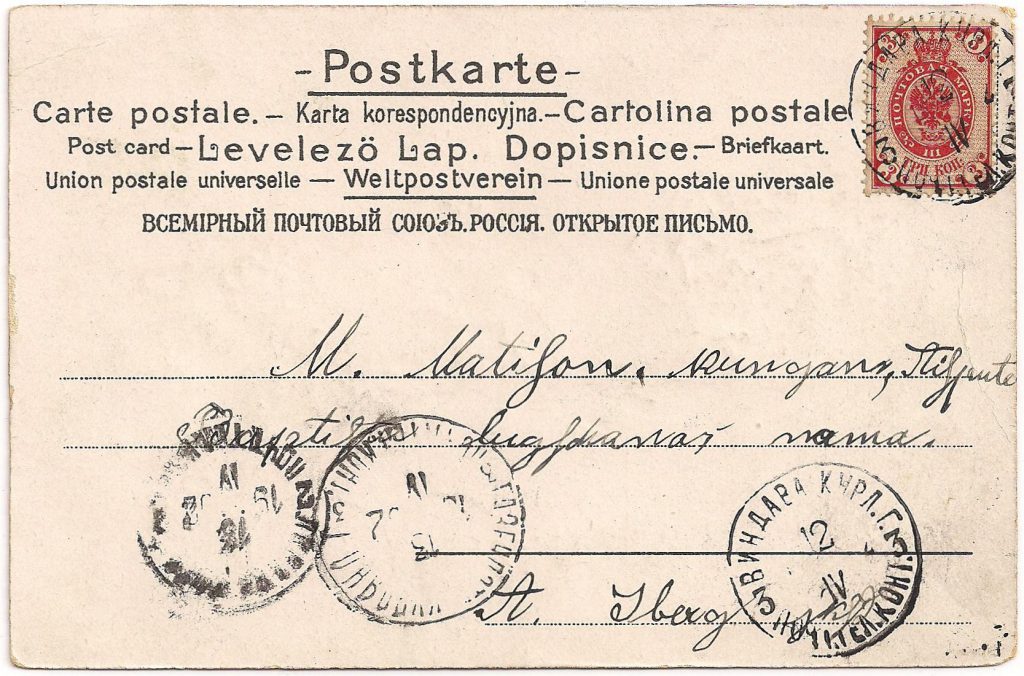
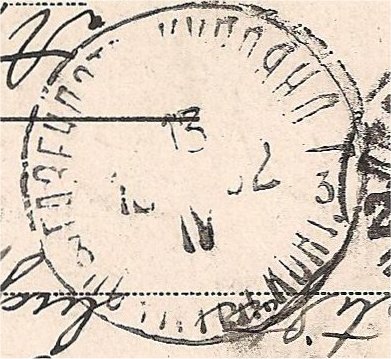
The arrival-postmark of ГАЗЕНПОТЪ [GAZENPOT], something unclear, is a later postmark, type crossed-date: in the middle the day stays first, under it the month (in Roman numerals), left of the whole the century and right the rest of the year.
On suggestion of the U.P.U., the Universal Postal Unionthe new stamps had to use Roman numerals for the month and in Russia circular 13 of 5 April 1890 were distributed the instruction for the new postmarks. According the EESTI-clasification this is type 6C: month in numerals with gubernia (the ‘crossed-date’-type).
The subdivion of type 6C:
- 6C1: indication П.Т.К. or ПОЧТ. ТЕЛ(ЕГР). КОНТ. , the abbrevation for ПОЧТОВО-ТЕЛЕГРАФНАЯ КОНТОРА (POCHTOVO-TELEGRAFNAYA KONTORA = Post-Telegraph Office)
So this postmark of ГАЗЕНПОТЪ [GAZENPOT]: type 6C1. - 6C2: indication П.Т.О. or ПОЧТ. ТЕЛ(ЕГР). ОТД, the abbrevation for ПОЧТОВО-ТЕЛЕГРАФНОЕ ОТДЬЛЕНIЕ (POCHTOVO-TELEGRAFNOE OTDELENIE = Post-Telegraph Sub- Office)
- 6C3: indication П.К.
- 6C4: indication П.О. or ПОЧТОВОЕ ОТДЬЛЕНIЕ (POCHTOVOE OTDELENIE = Sub Post-Office
- 6C5: indication П.С or ПОЧТОВОАЯ СТАНЦIЯ (POCHTOVAYA STANTSIYA = Postal Station (coach station)
- 6C6: indication В.П. (Parish Council)
EESTI = Estonia : philately & postal history handbook catalogue = Estland : Philatelie & Postgeschichte Handbuch Katalog / Vambola Hurt, Elmar Ojaste. – 1986 . – 767 p.. – With supplement 1988
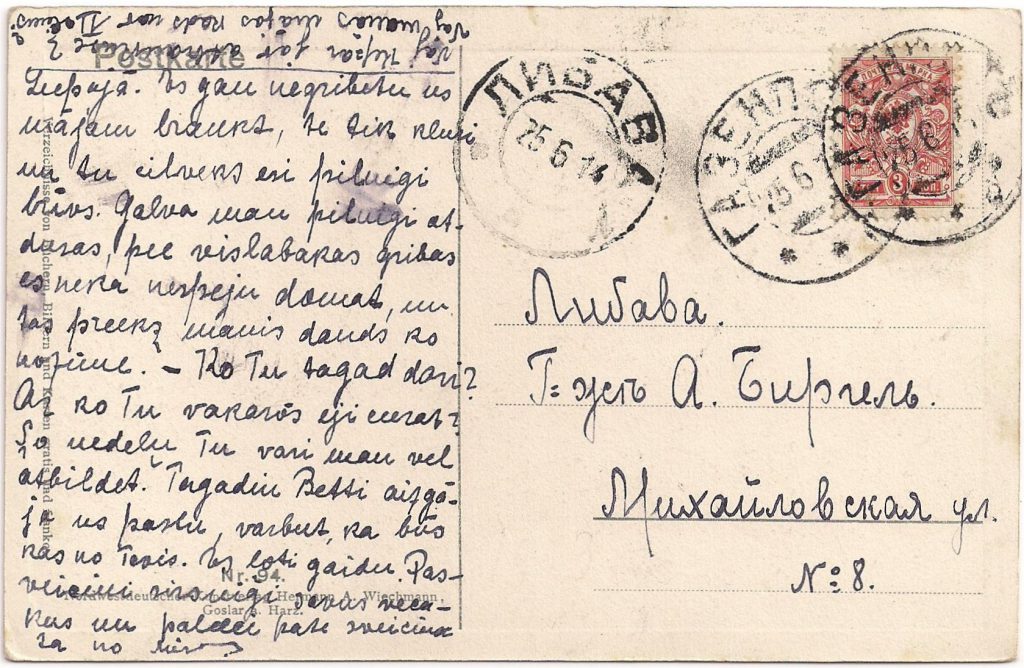
On this card from Aizpute to Liepāja is used the double circle datestamp of ГАЗЕНПОТЪ [GAZENPOT]. From 1903 double-ring-postmarks are used: circular nr. 9 of 3 February 1903 introduced the double-ring-postmarks. The old postmarks are replaced when they are worn out. Also a detailed description is given of the new postmarks.The postmarks consist of two rings, with the name of place in between. Day-month-year now stood on one line (in the year “19” has been omitted). There came two sorts of postmarks: bigger for the mail and smaller for receipts.
The handbook of Harry v. Hofmann gives a table with the standard Russian postmarks, used in Aizpute (part I, page 111-112): 12 different in this little place. Harry v. Hofmann distinguishes two different types of double circle postmarks, both reported for ГАЗЕНПОТЪ [GAZENPOT]: with date bridge thin (2 different) and with date bridge thick (3 different). Here clearly with thick datebridge.